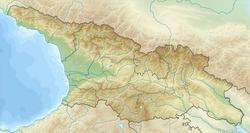Tsitsamuri
In the following article, we will delve into the exciting world of Tsitsamuri and explore its many facets. From its intriguing origin to its current repercussions, we will delve into this topic to unravel its secrets. Through exhaustive analysis and a critical approach, we aim to shed light on Tsitsamuri, offering our readers a comprehensive and informed view of this fascinating field. Join us on this tour of Tsitsamuri and discover everything behind this enigmatic universe.
Tsitsamuri
წიწამური | |
|---|---|
 | |
| Coordinates: 41°51′39″N 44°43′57″E / 41.86083°N 44.73250°E | |
| Country | |
| Region | Mtskheta-Mtianeti |
| Municipality | Mtskheta |
| Elevation | 488 m (1,601 ft) |
| Population (2014) | |
• Total | 124 |
| Time zone | UTC+4 (Georgian Time) |
 | |
Tsitsamuri (Georgian: წიწამური) is a small village outside Mtskheta, Georgia. It is known as the place where the nation's famous writer and poet, Ilia Chavchavadze, was assassinated in 1907.
Near Tsitsamuri (identified as the Seusamora of Strabo) a ruined acropolis of ancient Iberia was unearthed by the archaeologist Andria Apakidze in 1953. It is to be identified with the Zaden-tsikhe (ზადენციხე), i.e., "the fortress of Zaden" of the medieval Georgian chronicles. This fortress and a possible pagan temple was overlooked by Mount Zedazeni ("Upper Zaden") where later a Christian monastery was built.[1] A necropolis of the 1st century BC / 2nd century AD was brought to light early in the 1980s; a bronze batillum and an Italic oenochoe were among the finds.[2]
See also
References
- ^ Melikishvili, Giorgi et al. (1970), საქართველოს ისტორიის ნარკვევები (Studies in the History of Georgia), Vol. 1. Tbilisi: Sabch’ota Sakartvelo. (in Georgian)
- ^ Kacharava, D. Archaeology in Georgia 1980-1990 (Post-Prehistoric to Pre-Mediaeval). Archaeological Reports, No. 37 (1990 - 1991), pp. 79-86.

